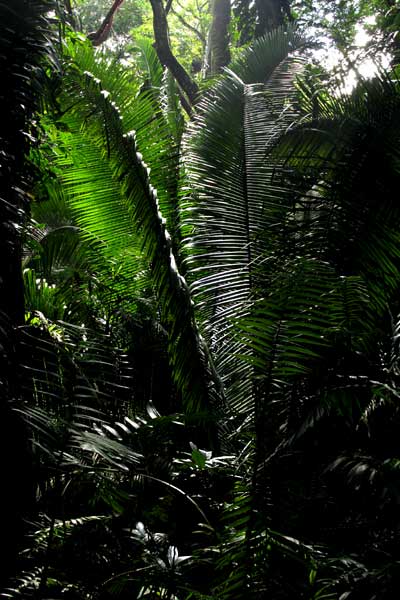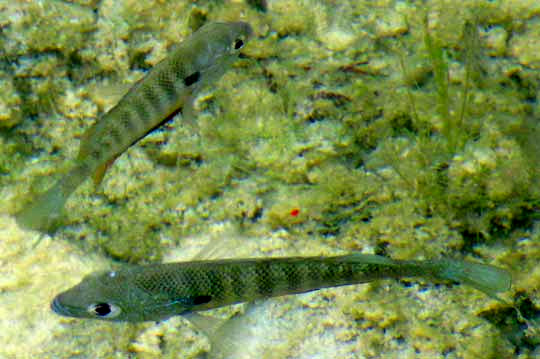Keeping in mind that most of the Earth's species have yet to be recognized and named, the National Geographic Biodiversity page in 2023 estimated that around 8.7 million species of plants and animals exist. However, only about 1.2 million have been identified and described so far, mostly insects. Millions of organisms are still to be discovered. Moreover, these numbers don't even consider forms of life other than plants and animals, such as fungi, algae and bacteria.
Without considering microorganisms -- whose estimated numbers are wildly different from one another -- here is another approximate view of species numbers:

 Spotted Cucumber Beetle, Diabrotica undecimpunctata, a member of the most species-rich order known on Earth
Spotted Cucumber Beetle, Diabrotica undecimpunctata, a member of the most species-rich order known on EarthNotice how many invertebrates (insects, spiders, worms, etc.) there are -- considerably over half of all named species! Also, look at how few of us vertebrates exist. Possibly the most surprising feature of the above chart is that beetles account for about 22% of all named species of these non-microscopic groups. It may be more than that. A 2015 paper published by the National Academy of Sciences suggests that beetles account for roughly 25% of all ~1.5 million known species!
No one knows how many kinds of organisms -- how many species -- exist on Earth. One problem is that the experts are divided into "lumpers and splitters," some lumping many different-looking populations of organisms into one species, while other experts describe each distinct population as a species all by itself.
 Young Cohune Palm, Attalea cohune, emerging in species-rich rainforest in Guatemala
Young Cohune Palm, Attalea cohune, emerging in species-rich rainforest in GuatemalaAlso, there's even some discussion about whether the whole concept of distinct species always is appropriate, especially among the fungi and bacteria. Some species appear to diffuse into one another. Are lichens, composed of fungal cells entangled with algal and/or cyanobacteria cells, along with abundant bacteria, really to be considered species?
The the total number of species on Earth is variously estimated to be between 5 and 50 million or more. Only about 1.8 million have actually been described, however. In the Animal Kingdom alone, between 15,000 and 20,000 new species are named each year.
The above-mentioned National Academy of Sciences paper of 2015 estimates that along with ~1.5 million beetle species there may be ~5.5 million species of insects, and 6.8 million species of terrestrial arthropods.
SPECIES DIVERSITY
A good way to see how your own part of Earth stacks up in terms of biodiversity is to visit the Biodiversity and Worldmap page of the UK's Natural History Museum. Here you'll see that the places with highest species diversity are near the Equator (the Amazon Basin, Central America, Southeast Asia) while the areas with lowest diversity are near the North and South Poles, and large deserts. Though this site counts only higher plants such as trees and grasses, it gives a good idea of general biodiversity.
 Bluegills, Lepommis macrochirus, common in the US's Tennessee River, which hosts more fish species than found in all of Europe
Bluegills, Lepommis macrochirus, common in the US's Tennessee River, which hosts more fish species than found in all of EuropeThough countries near the Equator receiving plenty of rain have the greatest biodiversity, the United States is especially biodiverse. In the book Precious Heritage: The Status of Biodiversity in the United States, Edited by Bruce A. Stein, Lynn S. Kutner, and Jonathan S. Adams (Oxford University Press, 2000), the following facts were reported:
- More than 200,000 species are now known from the United States -- a figure double the previous estimate. Nonetheless, this figure may represent fewer than half the plants, animals, and microbes yet to be discovered there.
- The US is particularly rich in aquatic life such as fishes, turtles, salamanders, and mussels.
- The US supports a more diverse collection of ecosystems than any other nation on Earth, hosting a large percentage of the world's broadleaf forests, temperate grasslands, and Mediterranean-climate vegetation.
DIVERSITY AT RISK
The US is rich in species diversity, but the authors of the above-mentioned book make clear that one-third of this diversity is imperiled:
- Aquatic life is particularly vulnerable. Nearly 70% of the nation's freshwater mussel species and over half of crayfish species are in trouble.
- More than 500 US species already have gone extinct or missing.
- Nearly 60% of the US outside of Alaska has lost most of its natural vegetation. Habitat destruction is the main threat to species in the US, with the introduction of alien species the second-most important cause for loss.
 Spiny Softshell Turtle, Apalone spinifera, threatened over parts of its distribution area
Spiny Softshell Turtle, Apalone spinifera, threatened over parts of its distribution areaYou may also be interested in the United Nations' Global Environment Outlook, publications and videos, which look at the state of the Earth's Ecosystem.